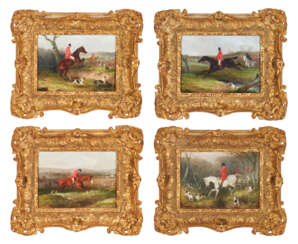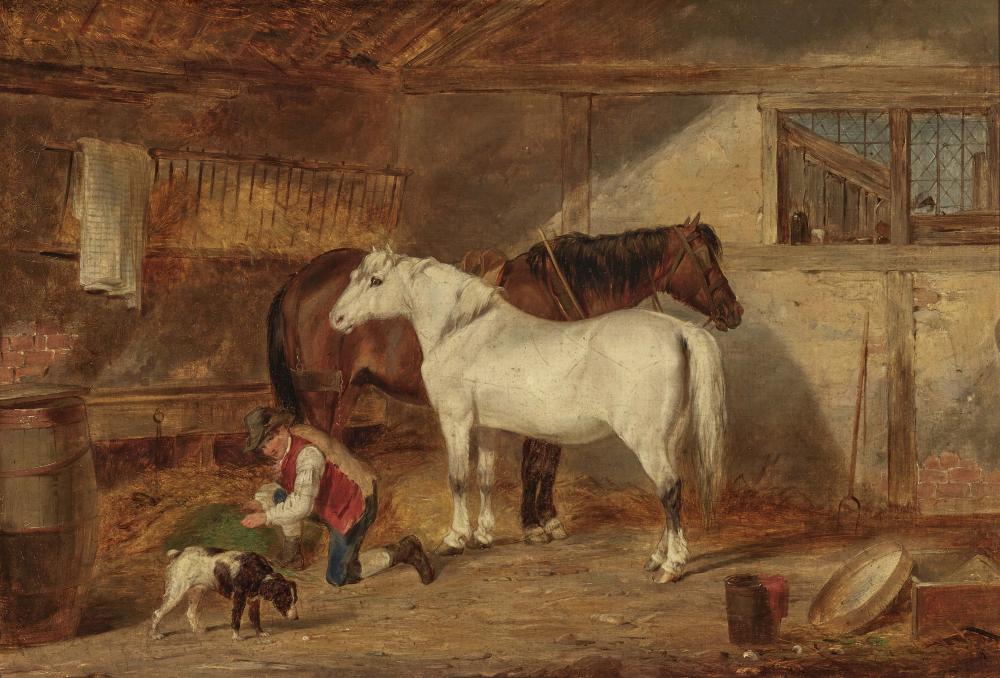
Paintings — The Collector: English & European Furniture, Ceramics, Silver & Works of Art

Francis Sartorius the Elder was a British animal painter.
Francis was the son and pupil of John Sartorius (c.1700-1780), an animal painter and founder of a four-generation dynasty of the famous Sartorius family of artists.
Francis Sartorius was a prolific and popular artist whose main subject matter was horses, racing and hunting scenes. He also collaborated with magazines as an illustrator.
His son John Nost Sartorius (1759-1828) and grandson John Francis Sartorius (1775-1831) were also famous horse painters.

John Frederick Herring the Elder was a British painter of Victorian England.
John had a passion for horses and painting from a young age. In his spare time from his day job as a sign painter and coachman, Herring painted horses for innkeepers and customers. Developing his talent, John specialized in drawing animals and loved to depict sporting events with horses. His impressive and vivid depictions of racehorses, cows and ducks as well as picturesque hunting scenes caught the eye of Queen Victoria. In 1845 Herring was appointed animal painter to Her Royal Highness the Duchess of Kent, followed by a commission from the reigning Queen Victoria, who remained a patron for the rest of his life.
A highly successful and prolific artist, Herring is considered one of the most important animal painters of mid-19th century Europe. He exhibited at the Royal Academy, the British Institution, and the Society of British Artists, where Herring became vice-president in 1842. Three of his sons also became artists.

John E. Ferneley was an English artist who specialised in depicting sport horses and hunting scenes. Although his rendition of horses was stylised, he is regarded as one of the great British equine artists, second perhaps only to George Stubbs.

John Frederick Herring the Elder was a British painter of Victorian England.
John had a passion for horses and painting from a young age. In his spare time from his day job as a sign painter and coachman, Herring painted horses for innkeepers and customers. Developing his talent, John specialized in drawing animals and loved to depict sporting events with horses. His impressive and vivid depictions of racehorses, cows and ducks as well as picturesque hunting scenes caught the eye of Queen Victoria. In 1845 Herring was appointed animal painter to Her Royal Highness the Duchess of Kent, followed by a commission from the reigning Queen Victoria, who remained a patron for the rest of his life.
A highly successful and prolific artist, Herring is considered one of the most important animal painters of mid-19th century Europe. He exhibited at the Royal Academy, the British Institution, and the Society of British Artists, where Herring became vice-president in 1842. Three of his sons also became artists.

Samuel Henry Alken the Younger was a British painter.
Samuel Henry Alken was the son of Henry Thomas Alken (1785-1851) and grandson of Samuel Alken Senior (1756-1815). Like his father, he usually depicted equestrian sporting scenes, but did so in sets. The most famous of the sets of paintings by Henry Alken, Jr. is a depiction of hunting at Belvoir Castle.

John Frederick Herring the Elder was a British painter of Victorian England.
John had a passion for horses and painting from a young age. In his spare time from his day job as a sign painter and coachman, Herring painted horses for innkeepers and customers. Developing his talent, John specialized in drawing animals and loved to depict sporting events with horses. His impressive and vivid depictions of racehorses, cows and ducks as well as picturesque hunting scenes caught the eye of Queen Victoria. In 1845 Herring was appointed animal painter to Her Royal Highness the Duchess of Kent, followed by a commission from the reigning Queen Victoria, who remained a patron for the rest of his life.
A highly successful and prolific artist, Herring is considered one of the most important animal painters of mid-19th century Europe. He exhibited at the Royal Academy, the British Institution, and the Society of British Artists, where Herring became vice-president in 1842. Three of his sons also became artists.

Jean Jansem (Armenian: Ժանսեմ; French: Jean Jansem), real surname Hovhannes Semerdjian (Armenian: Հովհաննես Սեմերջյան; French: Hovhannes Semerdjian) was a French artist of Armenian origin. He studied at the Paris Academy of Decorative Arts.
From the very beginning, Jean Jansem has chosen the outcasts, the unfortunate, and the victims of the Armenian genocide as his inspiration. Zhansem is a consistent bearer of national historical memory, which he brought to the visual ranks throughout his life.
Pat Steir is an American painter and printmaker. Her early work was loosely associated with conceptual art and minimalism, however, she is best known for her abstract dripped, splashed and poured "Waterfall" paintings, which she started in the 1980s, and for her later site-specific wall drawings.
Steir has had retrospectives and exhibitions all over the world.

Maximilien Luce was a prolific French Neo-impressionist artist, known for his paintings, illustrations, engravings, and graphic art, and also for his anarchist activism. Starting as an engraver, he then concentrated on painting, first as an Impressionist, then as a Pointillist, and finally returning to Impressionism.



















































